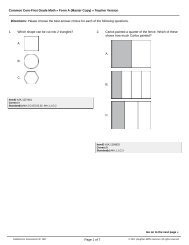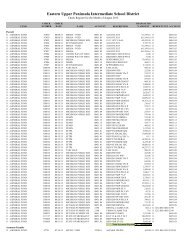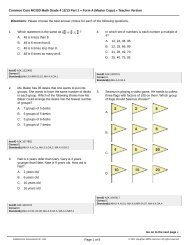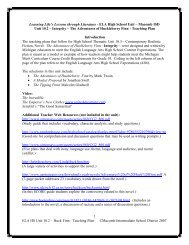Teaching Algebra with Manipulatives
Teaching Algebra with Manipulatives
Teaching Algebra with Manipulatives
Create successful ePaper yourself
Turn your PDF publications into a flip-book with our unique Google optimized e-Paper software.
Chapter<br />
14<br />
Probability<br />
<strong>Teaching</strong> Notes and Overview<br />
<strong>Algebra</strong> Activity<br />
Recording Sheet<br />
Finite Graphs<br />
(p. 206 of this booklet)<br />
Use With Lesson 14-1 as a follow-up activity.<br />
This corresponds to the activity on page 759 in<br />
the Student Edition.<br />
Objective Determine whether or not a<br />
network is traceable.<br />
Materials<br />
blank transparency<br />
transparency pen*<br />
* available in Overhead Manipulative Resources<br />
Form groups of two students for this activity.<br />
Before working the exercises, have the groups<br />
read about a finite graph, a network, a node,<br />
an edge and what it means for a network to be<br />
traceable. Ask students questions to check their<br />
understanding of the reading. Have each group<br />
follow the three steps to Collect the Data. You<br />
may want to display on a blank transparency,<br />
the graph that represents the streets on Alek’s<br />
newspaper route. As soon as the groups finish,<br />
ask them to tell and show the route they chose<br />
for Alek on the transparency. Record the four<br />
possible routes by listing the order of the<br />
street/avenue used. After listing the routes,<br />
have them complete Exercises 1–8. When the<br />
work is completed, discuss all of the responses<br />
to the exercises.<br />
Answers<br />
See Teacher Wraparound Edition p. 759.<br />
<strong>Algebra</strong> Activity<br />
Probability and Compound Events<br />
(p. 207 of this booklet)<br />
Use With Lesson 14-3.<br />
Objective Investigate the probability of<br />
compound events in which the simple events<br />
are joined by the word and.<br />
Materials<br />
2 paper bags<br />
2 red counters<br />
2 white counters<br />
Do the Collect the Data part of this activity<br />
<strong>with</strong> the whole class. Ask a volunteer to remove<br />
a counter from each bag and then to return the<br />
counters to their respective bags. Select a<br />
volunteer to record the color combination, that<br />
is, red/white or white/red or white/white, in the<br />
order that each student drew the counters on a<br />
transparency, board, or sketchpad. You may<br />
want to suggest that they label the bags 1 and<br />
2, and always draw out of bag 1 first, and<br />
replace the counter immediately to prevent<br />
mixing up the bags. Repeat 99 times. Students<br />
at their seats may record the information in the<br />
space provided on their worksheet. As a class,<br />
complete each exercise and discuss the answers.<br />
Answers<br />
1. Sample answer: about 25%<br />
2. Sample answer: about 25%<br />
3. Sample answer: about 25%<br />
4. Sample answer: about 25%<br />
<strong>Algebra</strong> Activity<br />
Theoretical and Experimental<br />
Probability<br />
(p. 208 of this booklet)<br />
Use With Lesson 14-5.<br />
Objective Compare theoretical probability and<br />
experimental probability by performing an<br />
experiment in which the outcomes are known.<br />
Materials<br />
paper bag<br />
20 two-inch pieces of paper<br />
In this activity, students perform an experiment<br />
in which the outcomes are known. They know<br />
how many of each letter is placed in the bag<br />
and can easily calculate the theoretical<br />
probability. Theoretical probabilities are<br />
determined mathematically and describe<br />
© Glencoe/McGraw-Hill 204 <strong>Teaching</strong> <strong>Algebra</strong> <strong>with</strong> <strong>Manipulatives</strong>







